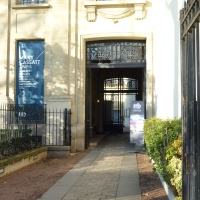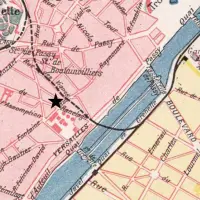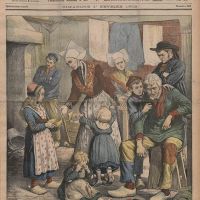The Rodin Museum is one of the most popular tourist sites in Paris. It encompasses a lovely old house surrounded by a huge garden, with several of Rodin’s bronze sculptures positioned here and there in the grounds. One sculpture in particular is placed so that all passersby can enjoy it, even without entering the museum precincts and paying the admission fee. Rodin’s depiction of “The Burghers of Calais” stands near a glass wall, so that anyone walking down the rue de Varenne can see it.
Why that piece in particular? I think there is a reason.
Only a few visitors know the story behind this particular sculpture. And most guidebooks give the barest outline. Essentially, it is this:
In the early part of the Hundred Years’ War, Edward III of England conducted a siege of Calais that lasted close to a year. Eventually, in August 1347, the inhabitants of Calais surrendered to the English forces. Edward III demanded that six of the most prominent citizens (burghers) leave the city with nooses around their necks, carrying the keys to the city. Six Calais citizens walked out to meet the king barefoot, in rags, gaunt from a year of near-starvation. Edward ordered that they be beheaded. His wife, however, intervened. According to the medieval chronicler Jean Froissart, the heavily pregnant Queen Philippa threw herself at her husband’s feet and said:
“Gentle sir, since I have crossed the sea from my home in great peril to be with you, I have desired nothing of you. Now therefore I humbly beg you, in honour of God and for the love of me, that ye will have mercy on these six citizens.”
The king looked sullenly at the queen and then said: “Ah, dame, I would you had been elsewhere, for if ye make such request to me, I cannot deny you. Wherefore I give them to you, to do your pleasure with them.”
The queen caused the six citizens to be brought to her apartment, had them clothed in garments suitable to their station, and gave them dinner. Finally she had each of them brought out of the English host under safe guard and set at liberty.
Can’t you just see the scene? The six dignified but emaciated men, the stern king, the tender-hearted, pregnant queen, the menacing English soldiers, the exhausted survivors watching anxiously from the walls of Calais… and the chronicler scribbling it all down for posterity, complete with a happy ending for all concerned.
Question is: did it really happen like that? Well, yes and no.
Since I share a first name with one of the protagonists, I thought I would find out a bit more about Queen Philippa and her role at Calais in 1347.
Edward III’s queen was known as Philippa of Hainault. She was born in Valenciennes (either in 1311 or in 1314). The town is in the Pas de Calais region, so the burghers were her compatriates.
The chronicler Jean Froissart was also born in Valenciennes, in about 1333, and Philippa was his patron. So it is possible that Froissart was inclined to heighten the drama or romance of her life’s events just a bit, for posterity.
By 1347 she had given birth to at least 10 children since her marriage to Edward in 1328. Although she went on to have two more children, most historians think it unlikely that she was pregnant when she was in Calais.
Some portraits of her, like the one above, make her look doe-eyed and willowy, but her funeral effigy below is probably more accurate. She was rather stout (having twelve children will do that to you), and no great beauty, but a sensible-looking woman who was apparently sufficiently authoritative to act as regent when her husband was away waging war (as he often was). She arrived in Calais fresh from having supervised a victorious battle against the Scots. Froissart says she led the troops herself, but he may be exaggerating. Still, she sounds brisk and competent, and battles didn’t faze her.
The siege itself is well documented. Edward needed possession of the town to keep the route from England to France open for English soldiers and military supplies crossing the Channel. Calais was a stoutly built stronghold surrounded by treacherous marshes, and attacking it would have been difficult – or perhaps Edward preferred to leave its fortifications intact. So he chose to starve out the residents.
In the early going, hundreds of women and children from the town were sent away by the French commander. The English let them pass without harming them.
The ensuing siege lasted eleven months, during which the English set up a small garrison town outside the walls. Edward was hoping that the French king, Philip VI, would come to the rescue of the people of Calais, which would allow for a proper pitched battle against his foe. Thousands of English soldiers were there, ready for a fight. But the French king (who was, by the way, Philippa’s uncle) never appeared.
When King Philip failed to appear after all those months, the residents of Calais had to admit defeat. At that point, things get a little murky. Froissart’s detailed account is all very well, but he wasn’t actually there. He got the story from someone else, and English accounts of the siege do not mention the scene with the pregnant queen on her knees. So what actually happened?
There seems to be agreement that the six men did emerge to signal the surrender of Calaias. According to one French historian, the business with the barefoot burghers was a typical surrender ceremony, based on medieval penitential rites, and by no means unique to Calais. Apparently, the ritual allowed the conquering sovereign to retain his authority while pardoning those at his mercy.* This theory suggests that executing the six burghers would have represented a shocking breach of protocol.
An English historian suggests that Edward gave the order to execute the burghers because he was furious that he hadn’t been able to fight Philip. It wasn’t the first time Edward had wanted to massacre those at his mercy – but every time he had been talked down. “Aware of the accusations of cruelty which would be brought against him if these men were killed, Edward did what he had always previously done: he relented when begged to do so by someone dear to him… It was as if in each case he was trying to play the dread king, ‘terrible to his enemies’ as well as the compassionate monarch. At Calais, as elsewhere, it was a method which confused and frightened his enemies.”**
Philippa’s biographer also sheds light on a marriage in which the queen’s role seemed to be that of sorting out her husband’s impulsive gestures, good and bad: “It has been remarked of Edward that he was always more ready to be generous to an enemy that just to a friend; and he gave away posts and honours so lavishly that sometimes he forgot, and granted the same thing twice and three times over to different people, and was then annoyed because they grumbled.”*** Philippa’s job seems to have been keeping everything straight and smoothing ruffled feathers, and one imagines that interceding for six burghers was all in a day’s work for her. But she probably did her persuading quietly behind the scenes, rather than in public.
Nevertheless, the story of a pregnant Philippa on her knees became celebrated through Froissart’s chronicles. The story also symbolized French heroism in defeat. Rodin created the sculpture in the 1890s, two decades after a French defeat at the hands of the Germans, giving three-dimensional shape to popular national heroes of the time.
I think that is why this particular sculpture is visible to all who walk down the rue de Varenne. It is (or was once) a part of the French psyche and their sense of national pride. Six humbled but dignified men, ready to accept their fate, holding the moral high ground, if not the military power.****
Froissart’s story also did wonders for Queen Philippa’s reputation, and may account for the survival of her unusual name. I’m happy to share it with her.
Text and original photographs by Philippa Campsie.
* Jean-Marie Moeglin, Les bourgeois de Calais: Essai sur un mythe historique. Paris: Albin Michel, 2002.
**Ian Mortimer, The Perfect King: The Life of Edward III Father of the English Nation. London: Jonathan Cape, 2006, p. 253.
***B.C. Hardy, Philippa of Hainault and Her Times, London: John Long, 1910, p. 184.
****As for the rest of the inhabitants of Calais, they were expelled, and the city was settled with English merchants and their families. It remained an English stronghold in France until the French reconquered the city in 1558.


























That little history lesson was very interesting – thank you
Pingback: The Paris Blog: Paris, France Expat Tips & Resources »Blog Archive » The Burghers of Calais
Pingback: Connaissez-vous Paris? | Parisian Fields
Pingback: The further adventures of the Nurse Who Wore Pearls | Parisian Fields
It is interesting also to note that the sculpture was at first refused by the population of Calais, because he has not made them “sufficiently heroic” and was only installed after much discussion. Also Rodin wanted it installed on the soil so that they might seem to be part of the population; at the musée Rodin they are at soil height; but not so in Calais.
Forgot another detail; King Philippe had gone to Calais, but when the saw the number of English soldiers , he turned back.
Pingback: Theme Rodin – Oh, border!